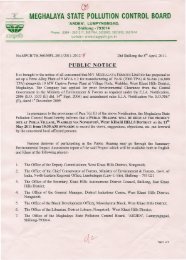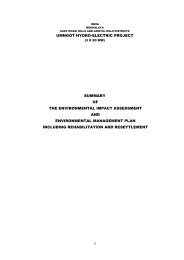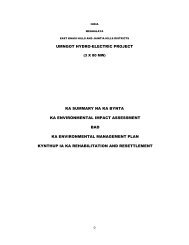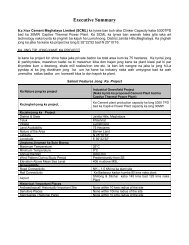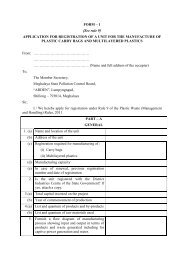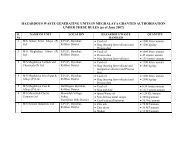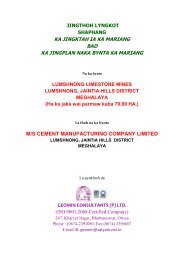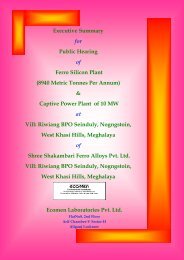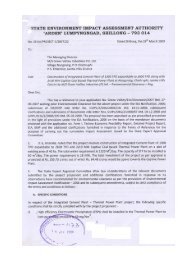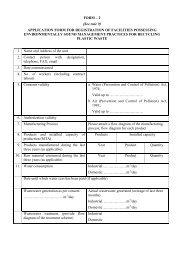Draft Environmental Impact Assessment Report - Meghalaya State ...
Draft Environmental Impact Assessment Report - Meghalaya State ...
Draft Environmental Impact Assessment Report - Meghalaya State ...
Create successful ePaper yourself
Turn your PDF publications into a flip-book with our unique Google optimized e-Paper software.
Description of the EnvironmentSillimanite the deposits are found in massive form scattered in 27 major or minordeposits in Nongstoin area and is reputed to contain the best quality in the worldand is famous for its ideal properties as natural refractory. It occurs at places inassociation with Corundum;The age of the rock types exposed along NH-44 between Jowai (Km 63) toAssam Border (Km 172) are Archeans to Tertiary group of rocks. Lithologicaldistribution of rock types along NH-44 between Km 63.00 to Km 172.00 may bereferred in Annexure 3.1.MiningThe total deposit of coal in Jaintia Hills district of the state is approximately 40million tones spreading over patches of different sizes. The areas where coalmining is prominent are Bapung, Lakadong, Jarain-Shkentalang, Lumshnong,Malwar-Musiang-Lamare, Sutnga, Ioksi, Chyrmang and Mutang. Bapung has thelargest deposit of 34 million tonnes covering an area of 12 km2. The maincharacteristics of the coal found in Jaintia Hills are its low ash content, highvolatile matter, high calorific value and comparatively high sulphur content. Thecoal is mostly sub-bituminous in character. The physical characteristics of thecoal of Jaintia Hills district are that it is hard, lumpy, bright and jointed.Composition of the coal revealed by chemical analysis indicates moisture contentbetween 0.4 to 9.2 percent, ash content between 1.3 to 24.7 percent, andsulphur content between 2.7 to 5.0 percent. The calorific value ranges from 5,694to 8230 kilo calories/kilogram (Directorate of Mineral Resources, 1985)The mining activities along the existing road are small-scale ventures controlledby individual owners of the land. Coal extraction is done unscientifically byprimitive sub-surface mining method commonly known as ‘rathole’ mining(Fig. 3.5). In this method, the land is first cleared by cutting and removing theground vegetation and then pits ranging from 5 to 100 m2 are dug into the groundto reach the coal seam. Thereafter, tunnels are made into the seam sideways toextract coal, which is first brought into the pit by using a conical basket or awheelbarrow and then taken out and dumped on nearby unmined area. Finally,the coal is carried by trucks to the larger dumping places near highways for itstrade and transportation. Entire roadsides in and around mining areas are usedfor piling of coal, which is a major source of air, water and soil pollution. Off roadmovement of trucks and other vehicles in the area causes further damage to theecology of the area. Hence, a large extent of the land is spoiled and denuded ofvegetal cover not only by mining but also by dumping and storage of coal andassociated vehicular movement (Fig. 3.6). Mining operation, undoubtedly hasbrought wealth and employment opportunity in the area, but simultaneously haslead to extensive environmental degradation and erosion of traditional values inthe society. <strong>Environmental</strong> problems associated with mining have been feltseverely because of the region’s fragile ecosystems and richness of biologicaland cultural diversity. The indiscriminate and unscientific mining, absence of postmining treatment and management of mined areas are making the fragileecosystems more vulnerable to environmental degradation and leading to largescale land cover/ land use changes. The list of coal storage locations along theproject road is given in Annexure 3.2<strong>Draft</strong> <strong>Environmental</strong> <strong>Impact</strong> <strong>Assessment</strong>3 - 4



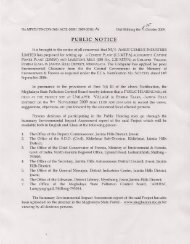

![[FORM I] - Meghalaya State Pollution Control Board](https://img.yumpu.com/49771786/1/190x245/form-i-meghalaya-state-pollution-control-board.jpg?quality=85)

